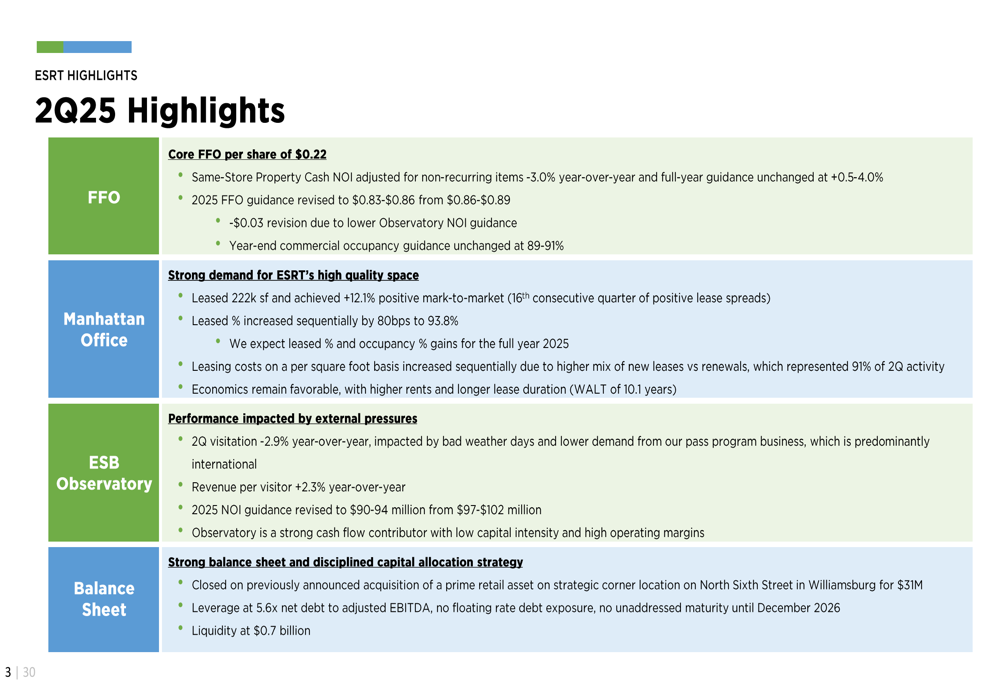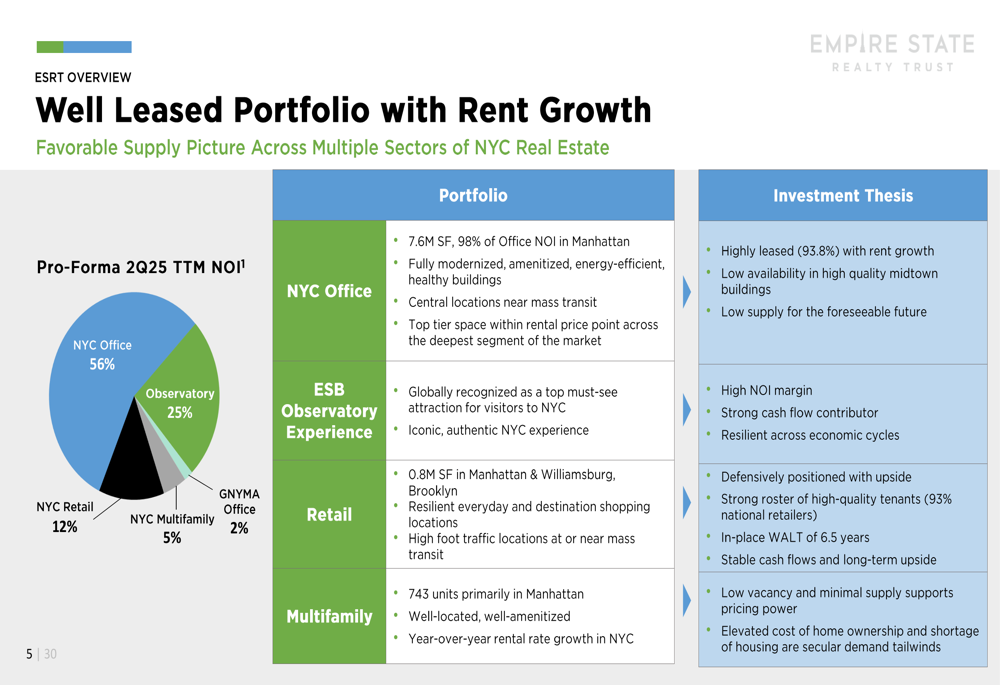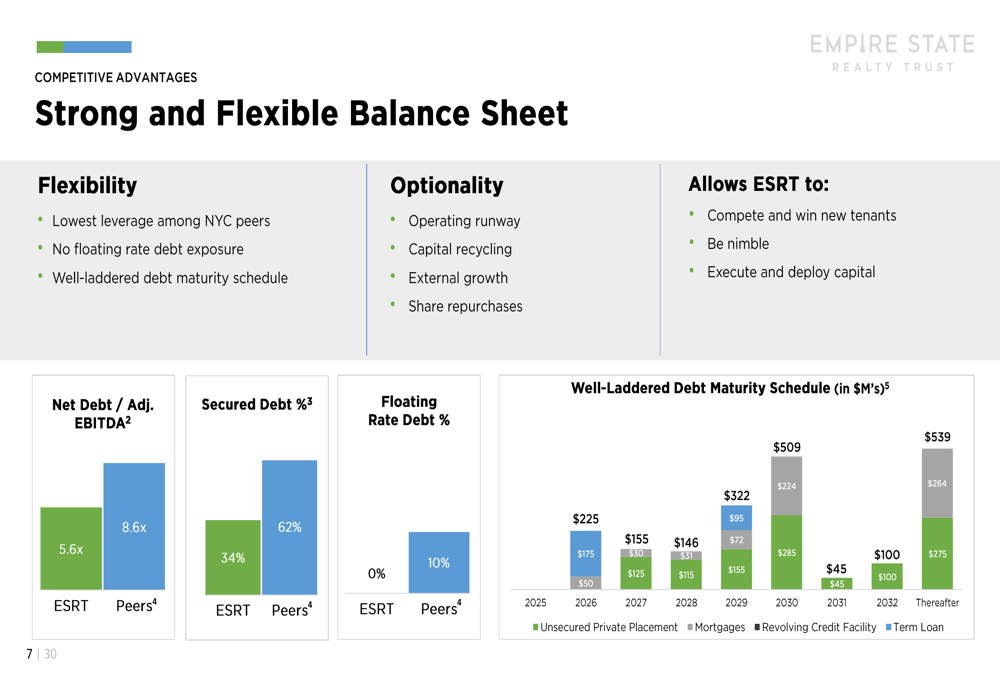These are top 10 stocks traded on the Robinhood UK platform in July
Introduction & Market Context
Empire State Realty Trust (NYSE:ESRT) released its second-quarter 2025 investor presentation on July 24, revealing a mixed performance characterized by robust Manhattan office leasing activity but challenges in its Observatory business. The company’s stock closed at $7.77, up 2.19% on the day, continuing its recovery from the 52-week low of $6.56 while remaining well below its 52-week high of $11.62.
ESRT positions itself as a pure-play New York City REIT with diversified income streams across office, retail, multifamily, and its iconic Empire State Building Observatory. The presentation emphasized the company’s completed portfolio transformation and strong balance sheet as key differentiators in the competitive NYC real estate market.
Quarterly Performance Highlights
Empire State Realty reported Core FFO of $0.22 per share for Q2 2025, with Same-Store Property Cash NOI decreasing by 3.0% year-over-year. Despite this decline, the company maintained its full-year Same-Store NOI guidance of +0.5-4.0%.
The Manhattan office portfolio showed particular strength, with 222,000 square feet leased during the quarter at a positive mark-to-market of 12.1%, marking the 16th consecutive quarter of positive lease spreads. The leased percentage increased sequentially by 80 basis points to 93.8%.
As shown in the following comprehensive quarterly highlights:

Leasing costs increased sequentially due to a higher mix of new leases versus renewals (91% of Q2 activity). However, economics remain favorable with higher rents and longer lease duration, with a weighted average lease term of 10.1 years.
Observatory Performance Challenges
The Empire State Building Observatory, which contributes approximately 25% of ESRT’s NOI, faced headwinds during the quarter. Visitation decreased by 2.9% year-over-year, though revenue per visitor increased by 2.3% compared to Q2 2024.
Due to these challenges, ESRT revised its 2025 Observatory NOI guidance downward to $90-94 million from the previous $97-102 million mentioned in the Q1 earnings report. This revision was the primary driver behind the company’s reduced 2025 FFO guidance, which was lowered to $0.83-$0.86 per share from $0.86-$0.89 previously.
Despite these challenges, the company emphasized that the Observatory remains a strong cash flow contributor with low capital intensity and high operating margins. The presentation highlighted the Observatory’s global recognition and its status as a must-see attraction for visitors to New York City.
Strategic Portfolio Transformation
ESRT’s portfolio transformation appears complete, with the company having invested approximately $1 billion to create top-tier, modernized, and energy-efficient assets. The company’s NOI is now predominantly derived from Manhattan properties, with a strategic shift away from suburban assets.
The portfolio diversification is clearly illustrated in the following NOI breakdown:

The company has executed a capital recycling strategy, selling five suburban assets totaling 1.5 million square feet since early 2022. Proceeds were tax-efficiently redeployed into approximately $675 million of high-quality NYC multifamily and retail assets, including properties in Manhattan and Williamsburg, Brooklyn.
This transformation has enhanced ESRT’s growth and cash flow profile, with the company projecting approximately $100 million in cumulative CAPEX savings and $78 million in cumulative incremental cash flow from 2025-2029.
Balance Sheet Strength & Capital Allocation
A key competitive advantage highlighted in the presentation is ESRT’s strong and flexible balance sheet. The company maintains the lowest leverage among NYC peers at 5.6x net debt to adjusted EBITDA, compared to the peer average of 8.6x. Additionally, ESRT has no floating rate debt exposure, while peers average 10%.
The following slide illustrates ESRT’s financial position relative to peers and its debt maturity schedule:

The company closed on a previously announced acquisition of a prime retail asset on North Sixth Street in Williamsburg for $31 million. With liquidity of $0.7 billion and no debt maturities until December 2026, ESRT emphasized its financial flexibility to pursue strategic opportunities.
Manhattan Office Market Dynamics
ESRT’s Manhattan office portfolio, which contributes 56% of NOI, is benefiting from favorable supply/demand dynamics according to the presentation. The company highlighted a multi-year period of low supply in Manhattan, with ESRT’s rental price points positioned meaningfully below new construction costs.
The company noted strong demand for its high-quality Manhattan office space, with low availability in high-quality midtown buildings creating upward pressure on net effective rents. ESRT projects continued mark-to-market upside on expiring in-place rents through 2029, ranging from 4.5% to 13.6% depending on the year.
The following slide details the Manhattan office market dynamics:

Forward Outlook & Guidance
Despite the downward revision to FFO guidance, ESRT maintained its year-end commercial occupancy guidance at 89-91%. The company expressed confidence in its ability to continue executing its leasing strategy in the Manhattan office market, while acknowledging the external pressures affecting Observatory performance.
The presentation emphasized ESRT’s focus on shareholder value through four key strategies: leasing space, selling Observatory tickets, managing the balance sheet, and achieving sustainability goals. The company highlighted its recognition as a leader in sustainability, ranking first among all Americas’ listed companies by GRESB for the second consecutive year.
Looking ahead, ESRT’s management appears focused on leveraging its strong balance sheet and diversified portfolio to navigate market challenges while pursuing strategic growth opportunities in its core New York City market.
Full presentation:
This article was generated with the support of AI and reviewed by an editor. For more information see our T&C.
